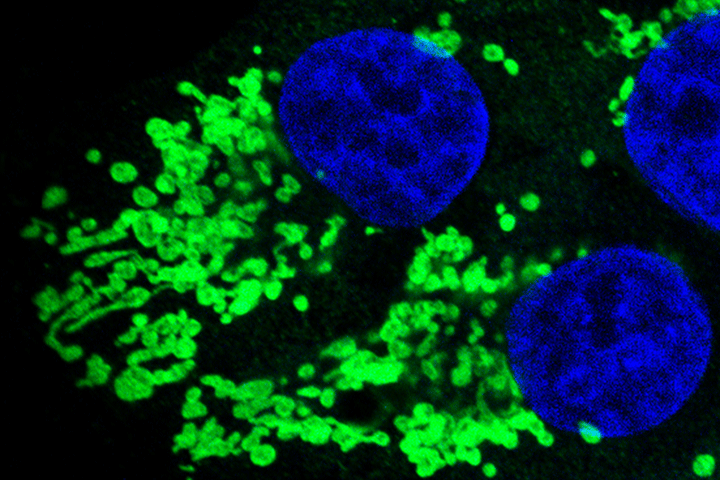PARP Inhibitors for Pancreatic Cancer Maintenance Treatment

Abramson Cancer Center
Traditional chemotherapy works by killing cells that grow and divide rapidly, such as cancer cells.
But newer approaches like targeted therapies take aim at very specific genetic changes and the proteins within cancer cells that spur their out-of-control growth. One such targeted therapy is called PARP inhibitors.
PARPs (poly [ADP-ribose] polymerases) are proteins that act like repair crews when a cell suffers DNA damage. The job of a PARP inhibitor-type drug is to stop the proteins from doing their repair jobs. The result: malignant cells progressively accumulate breaks in their DNA and lose their ability to divide and grow. Researchers have found that PARP inhibitors may be particularly effective against cancers with certain mutations, including BRCA and PALB2. This is because these cells are already partially defective in their ability to repair DNA damage; the PARP inhibitor delivers the second, and therefore fatal, blow, to the cancer cell.
Women with specific forms of ovarian cancers or other solid tumors such as fallopian tube cancers or breast cancer are already benefitting from PARP inhibitors. And numerous trials are looking at PARP inhibitors for potential use in prostate and other cancers that can be caused by mutations in BRCA or PALB2, such as pancreatic cancer. Although it’s too early to say that PARP inhibitors will provide more options to pancreatic cancer patients who carry specific genetic mutations, researchers are hopeful.
A Potential Role in Maintenance Therapy
One specific area of interest for PARP inhibitors in pancreatic cancer treatment is their potential role in so-called maintenance therapy—an approach used to prevent or delay a cancer’s growth if the cancer has already been quieted down by chemotherapy.
Unfortunately, pancreatic cancer patients whose disease has stabilized don’t have a lot of options when it comes to maintenance therapy, explains medical oncologist Dr. Kim Reiss Binder, an Assistant Professor of Medicine at the Hospital of the University of Pennsylvania in Philadephia. She’s leading a trial using a PARP inhibitor called rucaparib as a form of pancreatic cancer maintenance therapy. “It’s very frustrating that there are no good choices for maintenance therapy, so once people are on chemotherapy they don’t come off until they can’t tolerate it anymore or the disease progresses,” she says.
One reason for that lack of maintenance therapy options in pancreatic cancer “is that it wasn’t all that long ago we simply didn’t have any drugs for the disease—that is, drugs that could keep people alive long enough for maintenance therapy, so there wasn’t much research in this area,” Reiss Binder adds.
Indeed, it was only in 2013 that the U.S Food and Drug Administration approved nab-paclitaxel (Abraxane) for use in combination with gemcitabine (Gemzar) for metastatic pancreatic cancer. The four-drug combination of FOLFIRINOX was approved just a few years prior to that. “Now there is a substantial group of people who are doing very well with chemotherapy for months, if not years,” Reiss Binder says, “but the therapies can be very harsh in the long term, greatly affecting quality of life, and patients must also travel to a doctor’s office or clinic up to three times per month for infusions.”
PARP Inhibitors Offer a Simpler, Less Harsh Approach
Unlike these chemotherapy regimens which are given as infusions, PARP inhibitors are taken as a pill. And they are generally well-tolerated, though some patients may experience nausea and fatigue. There is a small risk for a rare condition called myelodysplastic syndrome, which affects the bone marrow, Reiss Binder adds.
Her rucaparib trial started enrolling patients last year and hopes to accrue 42 subjects. Eligible patients are those with advanced pancreatic cancer who have BRCA or PALB2 mutations. Participants must have been on platinum-type chemotherapy without their cancer growing before they start the PARP inhibitor trial. One of the major goals of the trial is to figure out whether these patients can safely stop receiving chemotherapy for a time while keeping their cancer at bay with the PARP inhibitor.
Despite the harsh side effects of long-term chemotherapy, Reiss Binder admits she had concerns that patients would not want to stop treatment no matter how tough the regimen. “When I first pitched this trial three years ago I kept asking myself ‘are people going to go for this,’” Reiss Binder explains. “I’d be taking them off chemotherapy that is working to keep the cancer stable . . . I wondered if patients would be willing to take that risk.” It turns out, she didn’t need to worry. “The answer was that everybody agreed to it,” she says. “What I didn’t realize is just how incredibly hard chronic chemotherapy must truly be for patients.”
The trial is at about the half-way point in recruitment, and patients have come from across the globe to learn more about it and to see if they qualify. Some patients have been on the trial for more than one year, which is as long as the study has been open. “Some of these patients are doing very, very well,” notes Reiss Binder, who works closely with the University of Pennsylvania’s Basser Center for BRCA. “They see their quality of life improving. Their hair grows back, they feel better, and some even want to go back to work. To see a patient with advanced pancreatic cancer start to feel good again is very rewarding.”
A Look To the Future
Just how many patients with pancreatic cancer carry the genetic mutations that make PARP inhibitors promising is somewhat debatable, with most experts saying that between 3 and 7 percent have inherited mutations in BRCA1 or BRCA2. But other patients may have similar mutations that result in the same downstream problem: difficulty repairing DNA damage. “All told, it may be that 10 or 15 percent of patients with pancreatic cancer have a mutation that might make PARP inhibitors effective,” Reiss Binder says. “BRCA or PALB2 are the ones we know the most about, but we may be able to apply the same strategy to additional mutations down the road.”
What that means is that in the future, as trials progress, PARP inhibitors used alone or in combination with other agents may prove beneficial to these patients, as well as others.
“One of the exciting things about being a physician-scientist at this point is that treating a tumor based solely on the organ it started in is not necessarily the best strategy for all people,” Reiss Binder explains. “There are certain driving mechanisms that need to be addressed. In regard to tumors with BRCA mutations, we’ve learned a tremendous amount from ovarian, breast, and prostate cancer. To build on that knowledge for the pancreatic cancer community is just so incredibly important because these patients deserve more options.”
The trial using the PARP inhibitor rucaparib is actively recruiting patients. To find out if you may qualify contact Colleen Redlinger at colleen.redlinger@uphs.upenn.edu.






